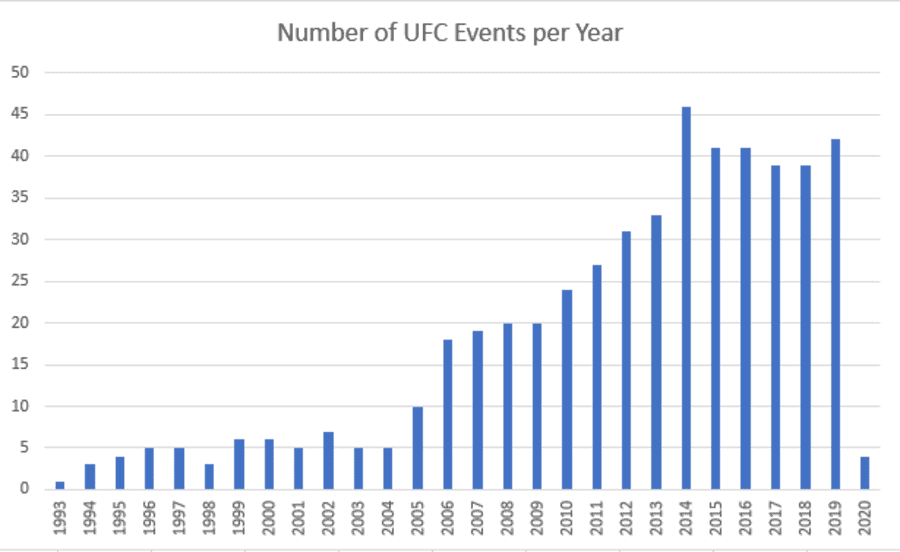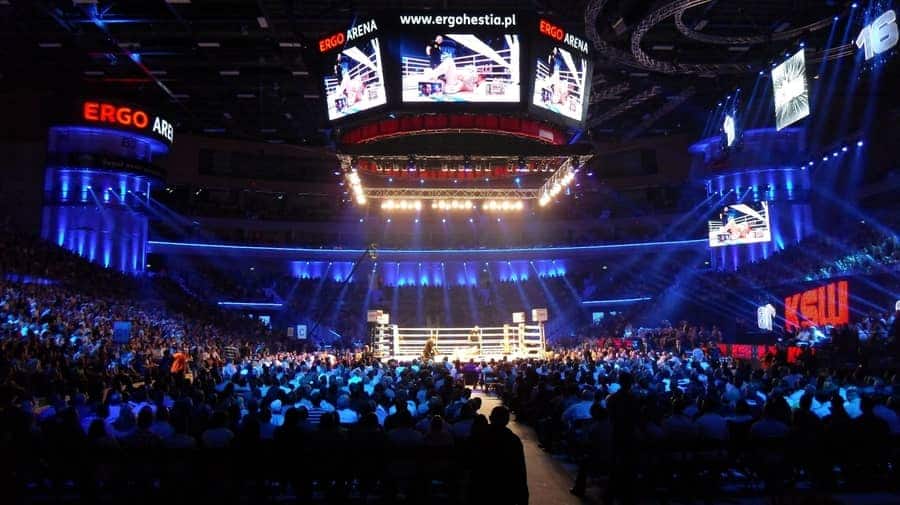The UFC holds its events, or cards, almost every weekend (usually Saturday nights). There are multiple fights during each event. Sometimes, more fights will be held during a particular event, sometimes less. Sometimes there are more recognizable fighters fighting, sometimes less. During some events, we’ll see championship fights, during some we won’t. So, what’s the difference between all these events? Or are they all the same?
The biggest type of UFC events is the PPV (pay-per-view) events. They are marked as “UFC “. The number after the “UFC” refers to the chronological order of the PPV event that was held, starting at UFC 1 and going all through the UFC 248 (at the moment the article was written).
Since these events have to be paid to be viewed, they almost always feature one or more championship fights. They also have features of the UFC’s most recognizable names.
But what about the other types of UFC events? As we said, there are UFC PPV events, but there are also UFC Fight Night events and UFC on ESPN type of events. Although all UFC events have a similar concept – featuring a set of scheduled fights – there are some differences. With UFC PPV (the so-called “numbered” UFC events) events being the largest, let’s talk about them a little bit first.
PPV UFC events:
As we already mentioned, PPV stands for pay-per-view. This means that, in order to watch “numbered” UFC events, one has to pay an additional sum of money, on top of having a subscription service, digital cable, or something else, depending on the viewing country. The PPV type of service is used when broadcasting professional boxing matches, UFC, pro wrestling, and sometimes even concerts.
UFC holds PPV events roughly once a month (sometimes there are 2 UFC events per month, and sometimes none, but both of these situations are rare). They are held in the world’s most famous fighting arenas, like the Madison Square Garden in New York, or the MSG Grand and T-Mobile Arena in Las Vegas. Sometimes, PPV events are held outside the USA, usually in Brazil, Canada, or Australia (usually when the champion or the challenger is from a particular country).
“Numbered” UFC cards have a championship fight serving as the main event. Sometimes there are 2 championship fights on the same card. UFC 205 and UFC 245 are still the only 2 UFC events in history that have featured 3 title fights on the same card.
At UFC 205, Eddie Alvarez and Conor McGregor fought for UFC Lightweight Championship; Tyron Woodley and Stephen Thompson fought for UFC Welterweight Championship, and Karolina Kowalkiewicz challenged Joanna Jędrzejczyk for UFC Women’s Strawweight Championship.
At UFC 245, Kamaru Usman fought Colby Covington for UFC Welterweight Championship; Alexander Volkanoski challenged Max Holloway for UFC Featherweight Championship; and Amanda Nunes and Germaine de Randamie fought for UFC Women’s Bantamweight Championship.
Although it is somewhat of a tradition for PPV events to be headlined with a championship fight, there are some exceptions. Some time ago, championship fights were the most talked about thing in UFC. Everyone wanted to see whether the champion would retain the title or not. As PPV events are the ones that bring the big bucks, it is common sense for them to feature the most popular fighters.
As stated, years ago, the champions were the ones who were the most popular. But ever since the “McGregor era”, things have changed a bit. With the global explosion of UFC’s popularity and tons of new viewers tuning in every day, some fighters are more popular than the current champions.
Conor McGregor is the perfect example – he headlined 3 of his 6 PPV events while not being a champion or not even fighting for the championship. UFC 244 also comes to mind, where the main event was a fight between Jorge Masvidal and Nate Diaz (neither of which was a champion or a contender), who fought for the BMF title. So as time goes by, there should be more and more main event fights on PPV events that are title fights.
Only a BMF can earn this belt! #UFC244 pic.twitter.com/VqOiQ0vlKk
— UFC (@ufc) November 1, 2019
With UFC PPV events serving as the biggest source of income for the company, the number of PPV tickets per event determines a fighter’s star power. So, let’s see which PPV events (and fighters who headlined those events) made the most PPV buys.
Top 10 Biggest UFC PPV events:
- UFC 229: Khabib vs. McGregor (2.4 million buys) – The biggest fight in UFC history by far. Featuring the clash between the most dominant fighter the world has ever seen, Khabib Nurmagomedov, and Irish global superstar unprecedented by no other, Conor McGregor.
- UFC 202: Diaz vs. McGregor II (1.65 million buys) – “Anytime. Any weight. Anywhere.” That was the motto of one of the biggest rematches in sports history featuring the fight of Nate Diaz and Conor McGregor at a 170 pounds limit.
- UFC 100 (1.6 million buys) – Held the record as the biggest UFC event until UFC 202. Featured the likes of Brock Lesnar vs. Frank Mir, George St-Pierre vs. Thiago Alves, Dan Henderson vs. Michael Bisping, and young Jon Jones also fighting on the same card.
- UFC 196: McGregor vs. Diaz (1.317 million buys) – The event that featured one of the biggest shocks in UFC history. Nate Diaz submitted McGregor, thus handing him his first UFC loss.
- UFC 206: Alvarez vs. McGregor (1.3 million buys) – The first time that UFC came to the Madison Square Garden in NYC. Also, the event where McGregor made history by knocking out Alvarez in the second round. He became the first man to hold two belts simultaneously (being the UFC Featherweight and Lightweight Champion at the same time).
- UFC 194: Aldo vs. McGregor (1.2 million buys) – The event that shot Conor McGregor into stardom, as was never seen before that. McGregor knocked out Aldo in just 13 seconds, setting the fastest knockout in UFC title fights history.
- UFC 116: Lesnar vs. Carwin (1.16 million buys) – Alongside UFC 100, one of the biggest PPV events at the time. The time when Brock Lesnar was by far the biggest star in the sport.
- UFC 207: Nunes vs. Rousey (1.1 million buys) – The event that marked the return of Ronda Rousey after losing her belt and status of invincibility one year earlier, at the UFC 193. The return wasn’t that successful for Ronda, as she was knocked out in the first round by Amanda Nunes.
- UFC 193: Rousey vs. Holm (1.1. million buys) – The most attended UFC event in history at the time, with 56,214 people filling the stadium in Melbourne, Australia. The event produced one of the biggest upsets in the history of the UFC, where Holly Holm knocked out Ronda Rousey, who was at the time thought to be absolutely invincible.
- UFC 121: Lesnar vs. Velasquez (1.05 million buys) – The third event in the top 10, which featured Brock Lesnar as the main fight. Lesnar lost the title in the first round by TKO from Cain Velasquez.
In this article, you can find exactly how much the UFC fighters are getting paid for these PPV events and what the other sources of their income are.
With “numbered” PPV UFC events being the best the company can offer, there are also “regular” UFC events almost every weekend. They are called UFC Fight Nights.

What’s the Difference Between “Numbered” UFC Events and UFC Fight Nights?
As already explained before, “numbered” UFC events are PPV, i.e. you have to buy a ticket to watch them. They feature the best fights on the roster, with championship fights headlining the event. On average, numbered UFC events are held once per month.
On the other hand, UFC Fight Nights are smaller types of events, usually held every weekend, that you can watch without buying the PPV. They consist of somewhat “smaller” fights and rarely feature a championship fight.
These days, UFC also features the so-called UFC on ESPN type of events. They are almost identical to the UFC Fight Night, except for the place where you can watch them.
Regarding the number of fights per different type of UFC event, they are almost identical, ranging around 12 or 13 fights (maybe less if some fight gets canceled). And now, let’s see where and how you can watch different types of UFC events.
Where to Watch UFC Events?
- UFC PPV events: to watch UFC PPV events, first you have to have a subscription to ESPN+, which costs $4.99 per month. Early Prelims of the PPV events are streaming on ESPN+ and UFC Fight Pass. Preliminary Card is streaming on ESPN. To watch the Main Card of the PPV event, you have to buy the PPV for that particular event. It costs (at the moment of writing) $64.99.
- UFC Fight Nights: to watch UFC Fight Nights, all you need is a subscription to ESPN+. You can watch all the fights on UFC Fight Nights there.
- UFC on ESPN: to watch these types of events, you just need to have access to ESPN.

